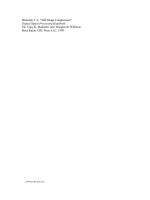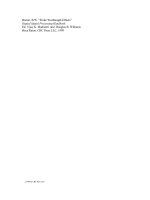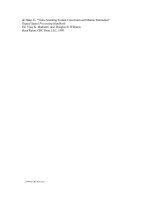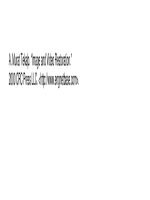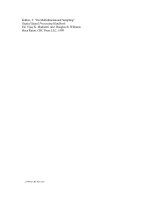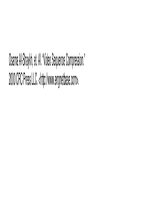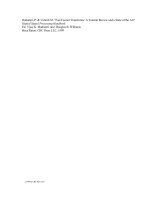Digital Signal Processing Handbook P3
Bạn đang xem bản rút gọn của tài liệu. Xem và tải ngay bản đầy đủ của tài liệu tại đây (253.33 KB, 19 trang )
Bomar, B.W. “Finite Wordlength Effects”
Digital Signal Processing Handbook
Ed. Vijay K. Madisetti and Douglas B. Williams
Boca Raton: CRC Press LLC, 1999
c
1999byCRCPressLLC
3
Finite Wordlength Effects
Bruce W. Bomar
University of Tennessee
Space Institute
3.1 Introduction
3.2 Number Representation
3.3 Fixed-Point Quantization Errors
3.4 Floating-Point Quantization Errors
3.5 Roundoff Noise
Roundoff Noisein FIR Filters
•
Roundoff Noisein Fixed-Point
IIR Filters
•
Roundoff Noise in Floating-Point IIR Filters
3.6 Limit Cycles
3.7 Overflow Oscillations
3.8 Coefficient Quantization Error
3.9 Realization Considerations
References
3.1 Introduction
Practical digital filters must be implemented with finite precision numbers and arithmetic. As a
result, both the filter coefficients and the filter input and output signals are in discrete form. This
leads to four types of finite wordlength effects.
Discretization (quantization) of the filter coefficients has the effect of perturbing the location of
the filter poles and zeroes. As a result, the actual filter response differs slightly from the ideal response.
This deterministic frequency response error is referred to as coefficient quantization error.
The use of finite precision arithmetic makes it necessary to quantize filter calculations by rounding
ortruncation. Roundoffnoiseisthaterrorinthefilteroutput thatresultsfromroundingortruncating
calculations within the filter. As the name implies, this error looks like low-level noise at the filter
output.
Quantization of the filter calculations also renders the filter slightly nonlinear. For large signals
this nonlinearity is negligible and roundoff noise is the major concern. However, for recursive filters
with a zero or constant input, this nonlinearity can cause spurious oscillations called limit cycles.
With fixed-point arithmetic it is possible for filter calculations to overflow. The term overflow
oscillation, sometimes also called adder overflow limit cycle, refers to a high-level oscillation that
can exist in an otherwise stable filter due to the nonlinearity associated with the overflow of internal
filter calculations.
In this chapter, we examine each of these finite wordlength effects. Both fixed-point and floating-
point number representations are considered.
c
1999 by CRC Press LLC
3.2 Number Representation
In digital signal processing, (B + 1)-bit fixed-point numbers are usually represented as two’s-
complement signed fractions in the format
b
0
· b
−1
b
−2
···b
−B
The number represented is then
X =−b
0
+ b
−1
2
−1
+ b
−2
2
−2
+···+b
−B
2
−B
(3.1)
where b
0
is the sign bit and the number range is −1 ≤ X<1. The advantage of this representation
is that the product of two numbers in the range from −1 to 1 is another number in the same range.
Floating-point numbers are represented as
X = (−1)
s
m2
c
(3.2)
where s is the sign bit, m is the mantissa, and c is the characteristic or exponent. To make the
representation of a number unique, the mantissa is normalized so that 0.5 ≤ m<1.
Although floating-point numbers are always represented in the form of (3.2), the way in which
this representation is actually stored in a machine may differ. Since m ≥ 0.5, it is not necessary to
store the 2
−1
-weight bit of m, which is always set. Therefore, in practice numbers are usually stored
as
X = (−1)
s
(0.5 + f)2
c
(3.3)
where f is an unsigned fraction, 0 ≤ f<0.5.
Most floating-point processors now use the IEEE Standard 754 32-bit floating-point format for
storing numbers. According to this standard the exponent is stored as an unsigned integer p where
p = c + 126
(3.4)
Therefore, a number is stored as
X = (−1)
s
(0.5 + f)2
p−126
(3.5)
where s is the sign bit, f is a 23-b unsigned fraction in the range 0 ≤ f<0.5, and p is an 8-b
unsigned integer in the range 0 ≤ p ≤ 255. The total number of bits is 1 + 23 + 8 = 32.For
example, in IEEE format 3/4 is written (−1)
0
(0.5 + 0.25)2
0
so s = 0, p = 126, and f = 0.25.
The value X = 0 is a unique case and is represented by all bits zero (i.e., s = 0, f = 0, and p = 0).
Although the 2
−1
-weight mantissa bit is not actually stored, it does exist so the mantissa has 24 b
plus a sign bit.
3.3 Fixed-Point Quantization Errors
In fixed-point arithmetic, a multiply doubles the number of significant bits. For example, the
product of the two 5-b numbers 0.0011 and 0.1001 is the 10-b number 00.000 110 11. The extra bit
to the left of the decimal point can be discarded without introducing any error. However, the least
significant four of the remaining bits must ultimately be discarded by some form of quantization so
that the result can be stored to 5 b for use in other calculations. In the example above this results in
0.0010 (quantization by rounding) or 0.0001 (quantization by truncating). When a sum of products
calculation is performed, the quantization can be performed either after each multiply or after all
products have been summed with double-length precision.
c
1999 by CRC Press LLC
We will examine three types of fixed-point quantization—rounding, truncation, and magnitude
truncation. If X is an exact value, then the rounded value will be denoted Q
r
(X), the truncated value
Q
t
(X), and the magnitude truncated value Q
mt
(X). If the quantized value has B bits to the right of
the decimal point, the quantization step size is
= 2
−B
(3.6)
Since rounding selects the quantized value nearest the unquantized value, it gives a value which is
never more than ±/2 away from the exact value. If we denote the rounding error by
r
= Q
r
(X) − X
(3.7)
then
−
2
≤
r
≤
2
(3.8)
Truncation simply discards the low-order bits, giving a quantized value that is always less than or
equal to the exact value so
− <
t
≤ 0
(3.9)
Magnitude truncation chooses the nearest quantized value that has a magnitude less than or equal
to the exact value so
− <
mt
<
(3.10)
The error resulting from quantization can be modeled as a random variable uniformly distributed
over the appropriate error range. Therefore, calculations with roundoff error can be considered
error-free calculations that have been corrupted by additive white noise. The mean of this noise for
rounding is
m
r
= E{
r
}=
1
/2
−/2
r
d
r
= 0
(3.11)
where E{} represents the operation of taking the expected value of a random variable. Similarly, the
variance of the noise for rounding is
σ
2
r
= E{(
r
− m
r
)
2
}=
1
/2
−/2
(
r
− m
r
)
2
d
r
=
2
12
(3.12)
Likewise, for truncation,
m
t
= E{
t
}=−
2
σ
2
t
= E{(
t
− m
t
)
2
}=
2
12
(3.13)
and, for magnitude truncation
m
mt
= E{
mt
}=0
σ
2
mt
= E{(
mt
− m
mt
)
2
}=
2
3
(3.14)
c
1999 by CRC Press LLC
3.4 Floating-Point Quantization Errors
With floating-point arithmetic it is necessary to quantize after both multiplications and additions.
The addition quantization arises because, prior to addition, the mantissa of the smaller number in
the sum is shifted right until the exponent of both numbers is the same. In general, this gives a sum
mantissa that is too long and so must be quantized.
We will assume that quantization in floating-point arithmetic is performed by rounding. Because
of the exponent in floating-point arithmetic, it is the relative error that is important. The relative
errorisdefinedas
ε
r
=
Q
r
(X) − X
X
=
r
X
(3.15)
Since X = (−1)
s
m2
c
, Q
r
(X) = (−1)
s
Q
r
(m)2
c
and
ε
r
=
Q
r
(m) − m
m
=
m
(3.16)
If the quantized mantissa has B bits to the right of the decimal point, || </2 where, as before,
= 2
−B
. Therefore, since 0.5 ≤ m<1,
|ε
r
| <
(3.17)
If we assume that is uniformly distributed over the range from −/2 to /2 and m is uniformly
distributed over 0.5 to 1,
m
ε
r
= E
m
= 0
σ
2
ε
r
= E
m
2
=
2
1
1/2
/2
−/2
2
m
2
d dm
=
2
6
= (0.167)2
−2B
(3.18)
In practice, the distribution of m is not exactly uniform. Actual measurements of roundoff noise
in [1] suggested that
σ
2
ε
r
≈ 0.23
2
(3.19)
while a detailed theoretical and experimental analysis in [2] determined
σ
2
ε
r
≈ 0.18
2
(3.20)
From (3.15) we can represent a quantized floating-point value in terms of the unquantized value
and the random variable ε
r
using
Q
r
(X) = X(1 + ε
r
)
(3.21)
Therefore, the finite-precision product X
1
X
2
and the sum X
1
+ X
2
can be written
fl(X
1
X
2
) = X
1
X
2
(1 + ε
r
)
(3.22)
and
fl(X
1
+ X
2
) = (X
1
+ X
2
)(1 + ε
r
)
(3.23)
where ε
r
is zero-mean with the variance of (3.20).
c
1999 by CRC Press LLC
3.5 Roundoff Noise
To determine the roundoff noise at the output of a digital filter we will assume that the noise due
to a quantization is stationary, white, and uncorrelated with the filter input, output, and internal
variables. This assumption is good if the filter input changes from sample to sample in a sufficiently
complex manner. It is not valid for zero or constant inputs for which the effects of rounding are
analyzed from a limit cycle perspective.
To satisfy the assumption of a sufficiently complex input, roundoff noise in digital filters is often
calculatedfor thecaseofazero-meanwhitenoise filterinputsignal x(n)ofvariance σ
2
x
. This simplifies
calculation of the output roundoff noise because expected values of the form E{x(n)x(n − k)} are
zero for k = 0 and give σ
2
x
when k = 0. This approach to analysis has been found to give estimates
of the output roundoff noise that are close to the noise actually observed for other input signals.
Another assumption that will be made in calculating roundoff noise is that the product of two
quantization errors is zero. To justify this assumption, consider the case of a 16-b fixed-point
processor. In this case a quantization error is of the order 2
−15
, while the product of two quantization
errors is of the order 2
−30
, which is negligible by comparison.
If a linear system with impulse response g(n) is excited by white noise with mean m
x
and variance
σ
2
x
, the output is noise of mean [3, pp.788–790]
m
y
= m
x
∞
n=−∞
g(n)
(3.24)
and variance
σ
2
y
= σ
2
x
∞
n=−∞
g
2
(n)
(3.25)
Therefore, if g(n) is the impulse response from the point where a roundoff takes place to the filter
output, the contribution of that roundoff to the variance (mean-square value) of the output roundoff
noise is given by (3.25) with σ
2
x
replaced with the variance of the roundoff. If there is more than one
source of roundoff error in the filter, it is assumed that the errors are uncorrelated so the output noise
variance is simply the sum of the contributions from each source.
3.5.1 Roundoff Noise in FIR Filters
The simplest case to analyze is a finite impulse response (FIR) filter realized via the convolution
summation
y(n) =
N−1
k=0
h(k)x(n − k)
(3.26)
When fixed-point arithmetic is used and quantization is performed after each multiply, the result of
the N multiplies is N-times the quantization noise of a single multiply. For example, rounding after
each multiply gives, from (3.6) and (3.12), an output noise variance of
σ
2
o
= N
2
−2B
12
(3.27)
Virtually all digital signal processor integrated circuits contain one or more double-length accumu-
lator registers which permit the sum-of-products in (3.26) to be accumulated without quantization.
In this case only a single quantization is necessary following the summation and
σ
2
o
=
2
−2B
12
(3.28)
c
1999 by CRC Press LLC
For the floating-point roundoff noise case we will consider (3.26) for N = 4 and then generalize
the result to other values of N. The finite-precision output can be written as the exact output plus
an error term e(n). Thus,
y(n) + e(n) = ({[h(0)x(n)[1 + ε
1
(n)]
+ h(1)x(n − 1)[1 + ε
2
(n)]][1 + ε
3
(n)]
+ h(2)x(n − 2)[1 + ε
4
(n)]}{1 + ε
5
(n)}
+ h(3)x(n − 3)[1 + ε
6
(n)])[1 + ε
7
(n)]
(3.29)
In (3.29), ε
1
(n) represents the error in the first product, ε
2
(n) the error in the second product, ε
3
(n)
the error in the first addition, etc. Notice that it has been assumed that the products are summed in
the order implied by the summation of (3.26).
Expanding (3.29), ignoring products of error terms, and recognizing y(n) gives
e(n) = h(0)x(n)[ε
1
(n) + ε
3
(n) + ε
5
(n) + ε
7
(n)]
+ h(1)x(n − 1)[ε
2
(n) + ε
3
(n) + ε
5
(n) + ε
7
(n)]
+ h(2)x(n − 2)[ε
4
(n) + ε
5
(n) + ε
7
(n)]
+ h(3)x(n − 3)[ε
6
(n) + ε
7
(n)]
(3.30)
Assuming that the input is white noise of variance σ
2
x
so that E{x(n)x(n − k)} is zero for k = 0, and
assuming that the errors are uncorrelated,
E{e
2
(n)}=[4h
2
(0) + 4h
2
(1) + 3h
2
(2) + 2h
2
(3)]σ
2
x
σ
2
ε
r
(3.31)
In general, for any N,
σ
2
o
= E{e
2
(n)}=
Nh
2
(0) +
N−1
k=1
(N + 1 − k)h
2
(k)
σ
2
x
σ
2
ε
r
(3.32)
Notice that if the order of summation of the product terms in the convolution summation is changed,
then the order in which the h(k)’s appear in (3.32) changes. If the order is changed so that the h(k)
with smallest magnitude is first, followed by the next smallest, etc., then the roundoff noise variance
is minimized. However, performing the convolution summation in nonsequential order greatly
complicates data indexing and so may not be worth the reduction obtained in roundoff noise.
3.5.2 Roundoff Noise in Fixed-Point IIR Filters
To determine the roundoff noise of a fixed-point infinite impulse response (IIR) filter realization,
consider a causal first-order filter with impulse response
h(n) = a
n
u(n)
(3.33)
realized by the difference equation
y(n) = ay(n − 1) + x(n)
(3.34)
Due to roundoff error, the output actually obtained is
ˆy(n) = Q{ay(n − 1) + x(n)}=ay(n − 1) + x(n) + e(n)
(3.35)
c
1999 by CRC Press LLC
